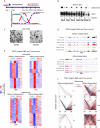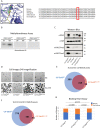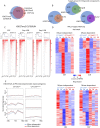Full methylation of H3K27 by PRC2 is dispensable for initial embryoid body formation but required to maintain differentiated cell identity
- PMID: 33688077
- PMCID: PMC8077505
- DOI: 10.1242/dev.196329
Full methylation of H3K27 by PRC2 is dispensable for initial embryoid body formation but required to maintain differentiated cell identity
Abstract
Polycomb repressive complex 2 (PRC2) catalyzes methylation of histone H3 on lysine 27 and is required for normal development of complex eukaryotes. The nature of that requirement is not clear. H3K27me3 is associated with repressed genes, but the modification is not sufficient to induce repression and, in some instances, is not required. We blocked full methylation of H3K27 with both a small molecule inhibitor, GSK343, and by introducing a point mutation into EZH2, the catalytic subunit of PRC2, in the mouse CJ7 cell line. Cells with substantively decreased H3K27 methylation differentiate into embryoid bodies, which contrasts with EZH2 null cells. PRC2 targets had varied requirements for H3K27me3, with a subset that maintained normal levels of repression in the absence of methylation. The primary cellular phenotype of blocked H3K27 methylation was an inability of altered cells to maintain a differentiated state when challenged. This phenotype was determined by H3K27 methylation in embryonic stem cells through the first 4 days of differentiation. Full H3K27 methylation therefore was not necessary for formation of differentiated cell states during embryoid body formation but was required to maintain a stable differentiated state.
Keywords: Differentiation; EZH2; Embryoid body; H3K27 methylation; Maintenance; PRC2.
© 2021. Published by The Company of Biologists Ltd.
Conflict of interest statement
Competing interests The authors declare no competing or financial interests.
Figures





Similar articles
-
Dissecting the role of H3K27 acetylation and methylation in PRC2 mediated control of cellular identity.Nat Commun. 2019 Apr 11;10(1):1679. doi: 10.1038/s41467-019-09624-w. Nat Commun. 2019. PMID: 30976011 Free PMC article.
-
EZH2 variants differentially regulate polycomb repressive complex 2 in histone methylation and cell differentiation.Epigenetics Chromatin. 2018 Dec 6;11(1):71. doi: 10.1186/s13072-018-0242-9. Epigenetics Chromatin. 2018. PMID: 30522506 Free PMC article.
-
Regulation of histone methylation by automethylation of PRC2.Genes Dev. 2019 Oct 1;33(19-20):1416-1427. doi: 10.1101/gad.328849.119. Epub 2019 Sep 5. Genes Dev. 2019. PMID: 31488576 Free PMC article.
-
Molecular Mechanisms Directing PRC2 Recruitment and H3K27 Methylation.Mol Cell. 2019 Apr 4;74(1):8-18. doi: 10.1016/j.molcel.2019.03.011. Mol Cell. 2019. PMID: 30951652 Free PMC article. Review.
-
The role of EZH1 and EZH2 in development and cancer.BMB Rep. 2022 Dec;55(12):595-601. doi: 10.5483/BMBRep.2022.55.12.174. BMB Rep. 2022. PMID: 36476271 Free PMC article. Review.
Cited by
-
Inseparable RNA binding and chromatin modification activities of a nucleosome-interacting surface in EZH2.Nat Genet. 2024 Jun;56(6):1193-1202. doi: 10.1038/s41588-024-01740-8. Epub 2024 May 14. Nat Genet. 2024. PMID: 38744974 Free PMC article.
-
Context-specific Polycomb mechanisms in development.Nat Rev Genet. 2022 Nov;23(11):680-695. doi: 10.1038/s41576-022-00499-0. Epub 2022 Jun 9. Nat Rev Genet. 2022. PMID: 35681061 Free PMC article. Review.
-
Histone methylation modification and diabetic kidney disease: Potential molecular mechanisms and therapeutic approaches (Review).Int J Mol Med. 2024 Nov;54(5):104. doi: 10.3892/ijmm.2024.5428. Epub 2024 Sep 20. Int J Mol Med. 2024. PMID: 39301658 Free PMC article. Review.
-
PRC1 drives Polycomb-mediated gene repression by controlling transcription initiation and burst frequency.Nat Struct Mol Biol. 2021 Oct;28(10):811-824. doi: 10.1038/s41594-021-00661-y. Epub 2021 Oct 4. Nat Struct Mol Biol. 2021. PMID: 34608337 Free PMC article.
-
LncRNA-Smad7 mediates cross-talk between Nodal/TGF-β and BMP signaling to regulate cell fate determination of pluripotent and multipotent cells.Nucleic Acids Res. 2022 Oct 14;50(18):10526-10543. doi: 10.1093/nar/gkac780. Nucleic Acids Res. 2022. PMID: 36134711 Free PMC article.
References
-
- Antonysamy, S., Condon, B., Druzina, Z., Bonanno, J. B., Gheyi, T., Zhang, F., MacEwan, I., Zhang, A., Ashok, S., Rodgers, L.et al. (2013). Structural context of disease-associated mutations and putative mechanism of autoinhibition revealed by X-ray crystallographic analysis of the EZH2-SET domain. PLoS ONE 8, e84147. 10.1371/journal.pone.0084147 - DOI - PMC - PubMed
-
- Basheer, F., Giotopoulos, G., Meduri, E., Yun, H., Mazan, M., Sasca, D., Gallipoli, P., Marando, L., Gozdecka, M., Asby, R.et al. (2019). Contrasting requirements during disease evolution identify EZH2 as a therapeutic target in AML. J. Exp. Med. 216, 966-981. 10.1084/jem.20181276 - DOI - PMC - PubMed
Publication types
MeSH terms
Substances
Grants and funding
LinkOut - more resources
Full Text Sources
Other Literature Sources
Molecular Biology Databases

